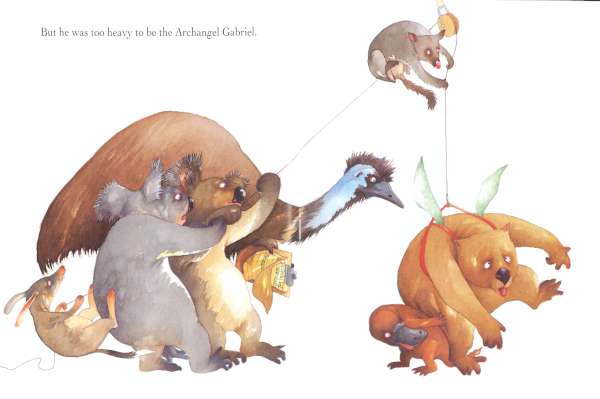Wombat Divine
Illustrated by Kerry Argent
“Wombat loved Christmas. He loved the carols and the candles, the presents and the pudding, but most of all he loved the bush Nativity play. For as long as he could remember Wombat had wanted to be in the Nativity. Now at last he was old enough to take part . . . ”
When people ask, as they invariably do, ‘Where do you get your ideas from?’ I always reply: ‘From the compost of my own life.’
However, this wasn’t entirely the case with Wombat Divine. My publishers at Omnibus Books, Sue Williams and Jane Covernton, asked me to write a typically Australian Christmas story. I told them I had never written a book to order and couldn’t do it. They promised to help. So, over the next two years we struggled as a threesome to get the story together. In the end I said it was hopeless, I just couldn’t do it, it wasn’t working, etc. They asked me to try one last time since they felt it was almost there. They suggested that I make a 32-page book and write the story in it. (Picture books are always 32 pages because of the way they’re folded in the printing process: in two, then four, then sixteen, then thirty two.) This suggestion worked. I was saved!
I am in love with this book. (I can hear my mother tut-tutting: ‘Boasting again, are we?’) It obeys my favourite maxims, which are that in any good story ‘character is everything’ and ‘only trouble is interesting.’ Whenever I read it aloud I almost always have a lump in my throat towards the end when dear old stage-struck wombat hangs his head and hopes he won’t cry. I also like the very gentle religious reminder to return Jesus to the centre of the Christmas story, which is missing from many Christmas books. And I like the way I played with the two meanings for ‘divine’.
After one public reading of Wombat Divine a woman waited until the end of a very long signing line to speak to me. It was 11 o’clock at night before she could talk to me.
‘Thank you so much for writing this book,’ she said. ‘I have a Down’s syndrome child and this wombat is just him. I couldn’t stop crying.’
‘How did you know it was a Down’s syndrome child?’ I asked. ‘I never mentioned it.’
‘I just knew.’
And she was right. My husband had directed play of Wilfrid Gordon McDonald Partridge with a class of special kids. A Down’s syndrome child had played Wilfrid beautifully and movingly. I had never forgotten the performance.
Children are amazing when, and if, we allow them to reach their potential.


